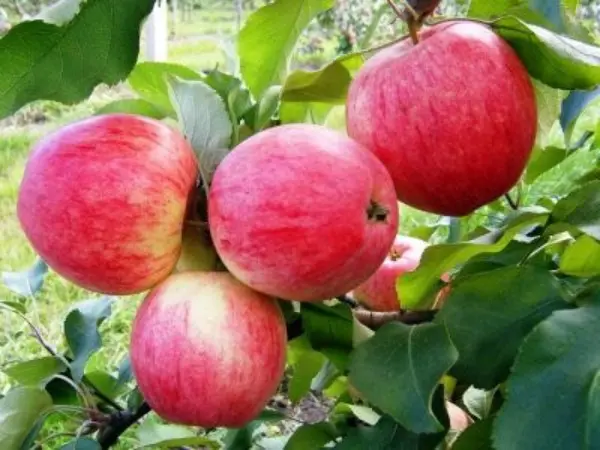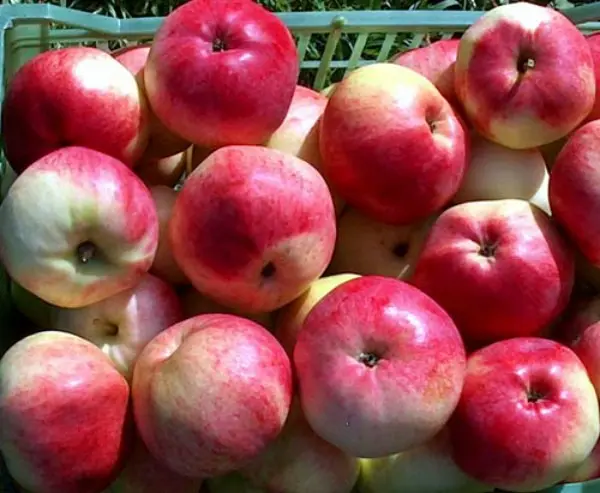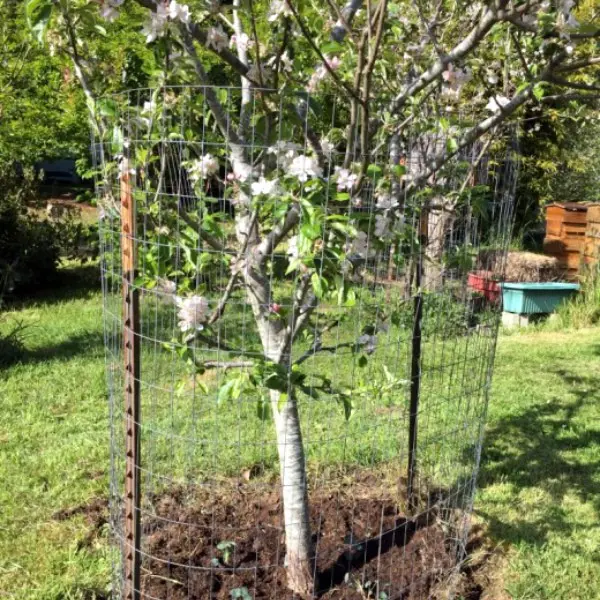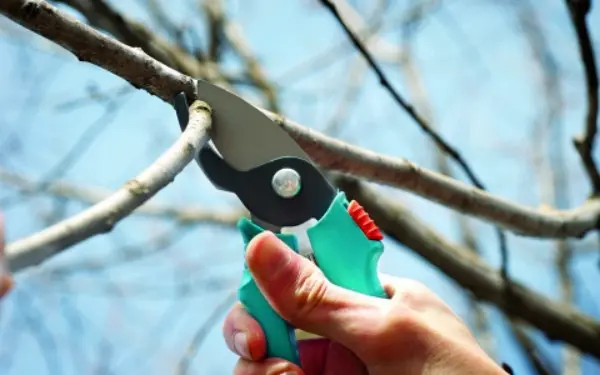Contents
“Marat Busurin” is a relatively new, but already beloved variety of dessert apples. Bright, juicy fruits are highly valued for their amazing taste and excellent marketability. Despite ripening in early autumn, with skillful storage, apples can be enjoyed even in winter. Trees of this variety are often planted in small private gardens and summer cottages, because the Marat Busurin apple tree successfully combines compact size and high productivity. Recommendations for growing an apple tree and its description will be presented in this article.
Description and characteristics of the variety
Apple tree variety “Marat Busurin” refers to semi-dwarf – its height does not exceed 3 meters. The tree is standard, the crown is neat, of medium density, rounded shape. The bark of the apple tree is dark gray, the young shoots are lighter in color. The branches are of medium thickness, with multiple annulus, round in cross section, located at right angles to the trunk, due to which the crown seems very lush.

The leaves are light green, with a slight yellowish tint, curved along the central vein. The leaf plate is glossy above, slightly pubescent below, dense, oblong in shape, serrated along the edge. Petioles not long, without stipules. The apple tree blooms with large saucer-shaped flowers of white color with a pinkish tinge.
The fruits of the “Marat Busurin” variety cannot be called very large, but they are larger than average – the weight of one apple varies from 100 to 250 g. The fruits are round in shape, slightly flattened, with slight ribbing. The surface is smooth, glossy, covered with a light bluish bloom. At harvest maturity, the skin color is greenish-yellow with blurred purple-red stripes covering more than half of the fruit. During storage, the main color of the apples becomes white-marble, and the red stripes become more intense.

As already mentioned, the variety is famous for its excellent taste and delicate apple aroma, something similar to Antonovka. The pulp is snow-white, very juicy, sweet and sour dessert taste. Apples are suitable both for fresh consumption and for the preparation of desserts and preparations. Thanks to a thin but very dense peel, they are well transported and stored for a long time.
The variety is considered autumnal. Harvesting takes place at the end of August – beginning of September, but in a cool place apples can be stored until winter.
The yield of the variety is high. The fruiting of a young apple tree begins at the age of 4, and in just a couple of years it reaches a fairly high level. From one adult tree, you can collect 100–120 kg of apples, despite the fact that the apple tree itself is not large. Also, the advantages of the variety include regular annual fruiting and relatively high winter hardiness.

History of breeding
The apple tree variety “Marat Busurin” was bred in 1982 by an employee of the All-Union State Institute of Economics and Trade, Kichina V.V. by crossing the well-known variety “Autumn Joy” with the American donor sample SR0523. Despite more than twenty years of history, this variety is considered new in horticulture, because it was entered into the State Register only in 2001.
To date, the variety has been zoned and is widely distributed in the Moscow region, since it was originally intended for this region. However, according to experts, these apple trees are considered promising not only in the central strip of the country, but also in areas located north of Moscow.
Peculiarities of growing
As the description indicates, the apple trees of the “Marat Busurin” variety are semi-dwarf, which means that planting and further care for this variety is somewhat simpler than for ordinary tall apple trees: it is more convenient to plant, spray, form a crown, and also harvest.

As for planting seedlings, here it is necessary to take into account some points:
- the landing site should be as sunny and protected from the wind as possible;
- soil for an apple tree needs fertile and loose – it grows best in black soil fertilized with organic matter (peat, humus);
- groundwater should be no higher than 1,5 m from the surface, since it is precisely this depth that the root system of an adult apple tree reaches;
- the planting pit for the seedling should be approximately 60×70 cm, and at least 0,5 m deep;
- humus, peat (0,5 buckets each), ash 700 g are placed from fertilizers at the bottom of the pit (ash can be replaced with potassium salt or potassium chloride in an amount of 300 g).
Otherwise, planting is carried out according to the standard scheme, only for apple trees of this variety it is necessary to drive a long peg into the center of the pit, to which the seedling will be tied.
Caring for apple trees consists in crown formation, top dressing, loosening of near-stem circles. Young trees are fed with complex mineral mixtures for 2-3 years after planting. In autumn, peat and compost can be added to the near-trunk circles – these materials will serve as fertilizer and mulch at the same time, warming the roots in winter. In the first year of life, the tree needs to be watered, especially in extreme heat. Watering is carried out once a week in the amount of 1-1 buckets for each tree.

The crown of the apple tree must be regularly shaped in order to help the branches to properly expend energy. Pruning is carried out in the spring, before the buds appear. An annual seedling is cut to a height of 40–50 cm. In the following years, only branches located at an acute angle, diseased and damaged, are cut.
In the first 2 years, it is advisable not to allow the tree to bloom, since in this case all the forces of the plant will be directed to the formation of fruits.
Fighting diseases and pests
Like all apple trees, the Marat Busurin variety is often attacked by harmful insects that not only spoil the appearance of the tree, but also destroy the fruits, thereby reducing productivity. From time to time, insects such as codling moths, sawflies, apple flower beetles can appear on apple trees, but the most formidable enemies of this variety are apple moths and green aphids.
Aphids are the most malicious pest of the apple tree. It reproduces at a crazy rate: one column of these microscopic insects can spread to most of the tree in just a few days. Having settled on the leaves and green shoots, the aphid sucks the juices out of them, which leads to damage and falling of the foliage.

To protect the tree from the pest, it is recommended that the apple tree be treated prophylactically with a Bordeaux mixture, copper or iron sulphate during bud break. Such treatment helps not only to prevent the appearance of aphids, but saves from fungal diseases. If a lot of insects have accumulated, insecticides are used (Nitrofen, Karbofos). From folk remedies for spraying, solutions of ash or tobacco are used.
Apple moths are no less dangerous than aphids, and not adult insects, but caterpillars that eat leaves during the flowering period, carry the greatest danger to the apple tree. Moth larvae hibernate in the bark of a tree, and with the onset of heat, they pupate and begin to destroy the apple tree. To combat moths, insecticides are used (Chlorophos, Karbofos). Preventive treatment is carried out before the leaves bloom and after flowering.
As for diseases, apple trees of this variety are considered quite resistant to fungus (scab, powdery mildew), however, in rainy summer conditions, the tree can get sick. To prevent this from happening, treat the apple tree in early spring and autumn with Bordeaux liquid, and burn the fallen dry leaves. Remember that diseases are easier to prevent than to get rid of them later.
Video “Early spring spraying of the garden”
This video is about how to protect the garden from pests and diseases, as well as top dressing with one early spraying.









